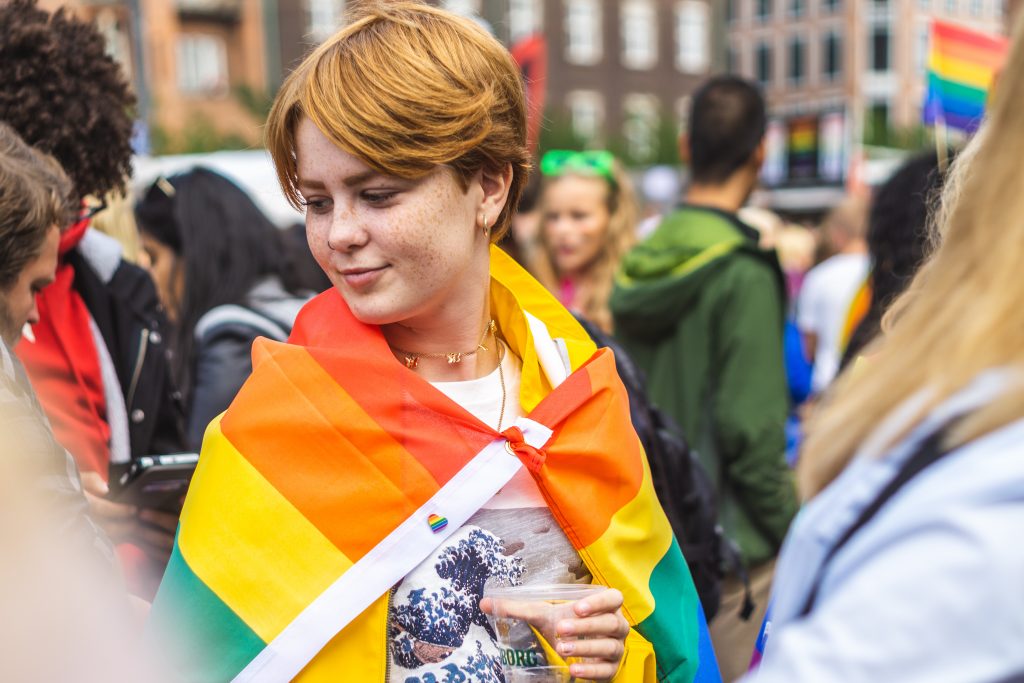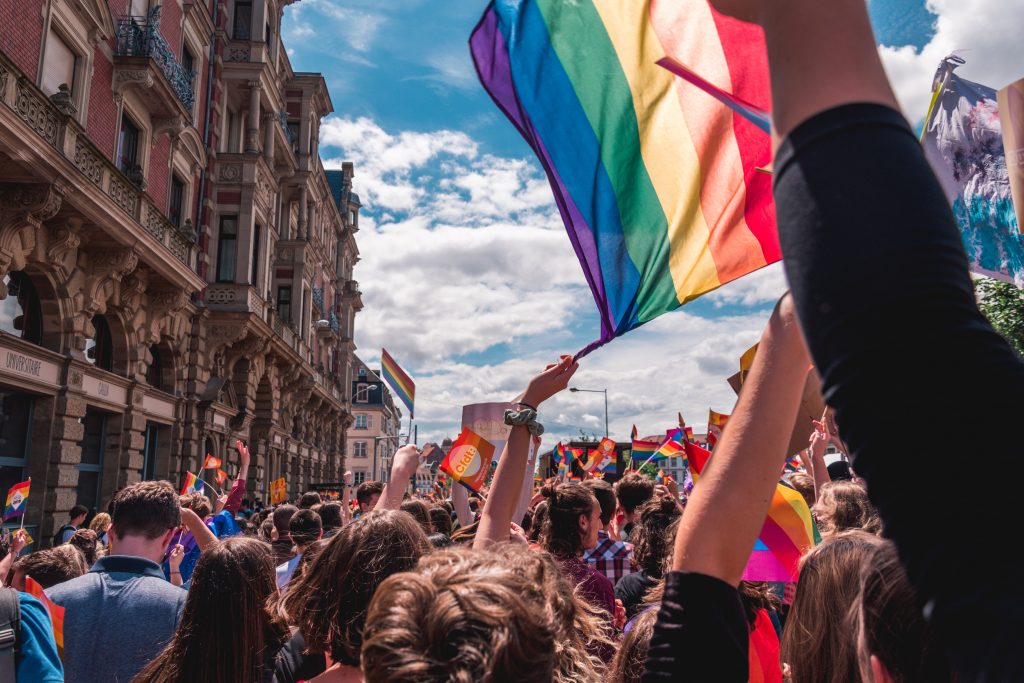
Lesbian, Gay, and Bisexual (LGB) individuals (often termed ‘sexual minorities’) are at increased risk of experiencing depression, anxiety, and substance dependence in comparison to heterosexuals (King et al., 2008; Plöderl & Tremblay, 2015), findings which extend to those identifying with other sexual minority identities (e.g., pansexual; Borgogna et al., 2019; Feinstein et al., 2023). This disparity is commonly explained by Meyer’s (2003) minority stress model, which implicates the unique additional stressors that sexual minorities face as a result of their minority identity (e.g., discrimination due to sexual identity, internalised homophobia).
Research also suggests that LGB individuals are at increased risk of suicide attempts (King et al., 2008), and a Mental Elf blog by Talen Wright summarises a review by Dunlop et al. (2020) showing that bisexual individuals are at increased risk of engaging with Non-Suicidal Self-Harm (NSSH). Research has also demonstrated that gay men and lesbians frequently cite their sexual orientation as partially or wholly the motive for self-harming (King et al., 2003).
Systematic reviews have identified gaps in the literature regarding our knowledge of sexual minorities in the UK, suicidality, and self-harm. Garrett Kidd et al. (2023) set out to overcome weaknesses of previous literature in this area (e.g., low statistical power, not adjusting for cofounders), with the aim of describing the proportion, characteristics, and associations between sexual orientation groups in the UK and self-harm and suicidality.

Research suggests that lesbian, gay and bisexual individuals are at increased risk of suicide and self-harm, although less is known about this in the context of the UK population.
Methods
Kidd et al. (2023) carried out a secondary analysis of the Adult Psychiatric Morbidity Surveys (APMS), combining the 2007 and 2014 survey years. APMS “uses a stratified, multistage random sampling design” to create a representative sample of the 16+ population living in private households in England, with data collected using computer-assisted face-to-face interviewing and computer-based self-interviewing for sensitive questions (e.g., sexuality, suicide).
For the current study, all participants with sexuality data available were included, which resulted in a sample of 10,443 people aged 16-64. Sexual orientation was defined slightly differently between survey years, so the authors “harmonised” the data to create four categories:
- Heterosexual and mainly heterosexual (reference group)
- Bisexual
- Lesbian/gay and mainly homosexual
- Other
The authors investigated the association of sexuality with lifetime Non-Suicidal Self-Harm (NSSH), past-year suicide attempt, and past-year suicidal thoughts, adjusting for potential confounders (e.g., age, common mental disorder, gender, survey year). They also tested for possible mediation by minority stress variables.
Results
Of the 10,443 participants:
- 10,016 identified as heterosexual and mainly heterosexual (96.0%)
- 116 identified as bisexual (1.1%)
- 163 identified as lesbian/gay and mainly homosexual (1.5%)
- 148 identified as other (1.5%)
Men represented the majority of those who identified as lesbian/gay (69.6%), whilst a larger proportion of females identified as bisexual (72.5%).
For the minority stress variables, the lesbian/gay group had the highest prevalence of a history of bullying victimisation (51.7%) compared to individuals identifying as bisexual (47.5%), heterosexual/mainly heterosexual (25.3%), and other (22.9%). The prevalence of past-year discrimination due to sexual orientation was also highest in the gay/lesbian group (23.2%), followed by those identifying as bisexual (9.4%), other (2.7%) then heterosexual/mainly heterosexual (0.3%).
Suicidality and self-harm prevalence
The prevalence of suicidal thoughts, suicide attempt, and Non-Suicidal Self-Harm (NSSH) was highest in the bisexual group, with 47.0% of this group reporting lifetime suicidal thoughts, 24.1% reporting a lifetime suicide attempt, and 26.9% reporting lifetime NSSH.
For all suicidality and self-harm outcomes, heterosexual individuals had the lowest prevalence (with the exception of past-week suicidal thoughts, and past-week suicide attempt, where there were no differences).
Table 1. The proportion (%) of each sexual orientation group reporting suicidal thoughts and suicide attempt (past-week, past-year, and lifetime) and NSSH (lifetime)
| Outcome variable | Heterosexual / mainly heterosexual | Bisexual | Lesbian / gay / mainly homosexual | Other | p value |
| Suicidal thoughts, past-week (%) | 0.9 | 2.0 | 1.0 | 1.5 | 0.483 |
| Suicidal thoughts, past-year (%) | 5.0 | 13.4 | 11.4 | 8.8 | < .001 |
| Suicidal thoughts, lifetime (%) | 16.7 | 47.0 | 36.7 | 18.4 | < .001 |
| Suicide attempt, past-week (%) | < 1 | 0.0 | 0.0 | 0.0 | 0.990 |
| Suicide attempt, past-year (%) | 0.7 | 4.3 | 1.1 | 1.5 | < .001 |
| Suicide attempt, lifetime (%) | 5.4 | 24.1 | 15.2 | 8.9 | < .001 |
| NSSH, lifetime (%) | 5.3 | 26.9 | 15.2 | 9.4 | < .001 |
Sexuality and past-year suicidal thoughts
Relative to heterosexuals, gay/lesbian individuals had greater odds of experiencing suicidal thoughts in the past year (OR = 2.47, 95% CI 1.37 to 4.48), even after controlling for socio-demographic factors and CMD (OR = 2.20, 95% CI 1.08 to 4.50). These increased odds remained when adjusting for socio-demographic factors, CMD, and discrimination (OR = 2.20, 95% CI 1.04 to 4.64), but decreased when adjusting for bullying (p > .05).
Bisexual individuals also showed increased odds of experiencing past-year suicidal thoughts relative to heterosexuals (OR = 2.95, 95% CI 1.60 to 5.45). These increased odds remained after adjusting for socio-demographic factors (OR = 2.37, 95% CI 1.28 to 4.38), but not after adjusting for both socio-demographic factors and CMD (p > .05).
Sexuality and past-year suicide attempt
Bisexual individuals (but no other sexual minority group) had higher odds of reporting a past-year suicide attempt relative to heterosexuals (OR = 6.23, 95% CI 2.10 to 18.53), including after adjusting for socio-demographic factors (OR = 3.95, 95% CI 1.23 to 12.72). However, this became non-significant after adjusting for both socio-demographic factors and CMD (p > .05).
Sexuality and lifetime NSSH
Relative to heterosexuals, the bisexual group (OR = 6.61, 95% CI 4.14 to 10.56) and the lesbian/gay group (OR = 3.20, 95% CI 2.00 to 5.11) had higher odds of reporting lifetime NSSH. This was slightly attenuated for both groups, but continued to be significant, after controlling for socio-demographic factors, common mental disorder, discrimination based on sexual orientation, and history of bullying.
Interactions with gender and survey year
There was no evidence to suggest that effects were modified by gender or by survey year.

Individuals identifying as bisexual or lesbian/gay were 6 times and 3 times more likely, respectively, to report lifetime non-suicidal self-harm.
Conclusions
In this population-based study, lesbian/gay and bisexual individuals were at increased risk of lifetime Non-Suicidal Self-Harm (NSSH) and past-year suicidal thoughts, relative to heterosexuals.
The elevated risk of NSSH in both lesbian/gay and bisexual individuals was slightly attenuated (but remained significant) for both groups when adjusting for common mental disorder (CMD), discrimination based on sexual orientation, and bullying, suggesting these factors may play a role in the increased risk experienced by these groups. In comparison, results showed that the increased risk of suicidal thoughts and past-year suicide attempt for bisexual individuals decreased when adjusting for CMD, suggesting that CMD may be a key component in this risk.
Finally, these disparities persisted over the period 2007-2014, despite the introduction of new protections for sexual minorities (e.g., The Equality Act, 2010), suggesting that these new protections have had no positive impact on suicidality and NSSH outcomes for sexual minorities.

Disparities in suicidality and self-harm outcomes experienced by LGB individuals have persisted over the period 2007-2014, despite the introduction of new protections for sexual minorities.
Strengths and limitations
This is the first population-based study in the UK to investigate the associations between sexual orientation, suicidal thoughts, suicide attempt, and Non-Suicidal Self-Harm (NSSH). By combing two sample years, the study has a large sample, giving the study higher statistical power relative to other studies and subsequently strengthening the reliability of the findings. This paper also uses validated measures to investigate several facets of self-harm and suicidality, allowing us to precisely understand where sexual minorities experience increased risk.
However, there are some limitations related to the study’s design:
- The study relied on participants defining only their sexual orientation, but there is growing recognition that individuals can identify as heterosexual, whilst also reporting same-sex attractions and/or behaviours. There is evidence that suggests that the number of people identifying as heterosexual and reporting same-sex attractions and/or behaviours may be similar, or even larger, than the number who identify as LGB (Hoy & London, 2018; Krueger et al., 2018; Gattis et al., 2012).
- Some research suggests that individuals identifying as “mostly heterosexual” experience disparities similar to other sexual minorities (Vrangalova & Savin-Williams, 2014), meaning it may have been more appropriate to categorise individuals identifying as “mainly heterosexual” into a group separate from “heterosexual”, or to carry out a sensitivity analysis.
- Whilst using a cross-sectional design with two time points allowed an examination of changes in the disparities experienced by sexual minorities before and after key legislation (i.e., the Equality Act 2010), a cohort study with the same sample would have provided stronger evidence on the impact (or lack of impact) of this legislation.
- Finally, a cohort study with mediation analysis is required before conclusions can be reached on whether the minority stress variables lie on the pathway between sexual orientation, suicidality, and self-harm outcomes.

This paper built on limitations of previous literature, including the use of validated measures to investigate several facets of self-harm and suicidality, allowing precision in identifying areas of risk for sexual minorities.
Implications for practice
This study deepens our understanding of suicidality and self-harm in sexual minorities in England. The results show an increased risk of suicidal thoughts and NSSH in bisexual and lesbian/gay individuals and highlight CMD, discrimination and bullying as potential contributors to this excess risk.
This knowledge may be useful for clinicians who are working with sexual minority individuals, particularly when carrying out risk assessments for suicidality and NSSH. It may be helpful for clinicians to be mindful of the possibility of a history discrimination and bullying, and clinicians can sensitively enquire about this, when appropriate, as part of comprehensive therapeutic assessments.
We must also look beyond clinicians to mental health services. It is important for mental health services to consider if they are meeting the needs of sexual minorities. Research suggests that not only do some sexual minority groups have poorer treatment outcomes in UK mental health services (Rimes et al., 2019), but they also face barriers within these services. Some of these barriers are summarised in a Mental Elf blog by Siobhan D’Almeida, who reported on a paper by Morris et al. (2022) that explored sexual minority service users’ experiences of Improving Access to Psychological Therapies (IAPT) and primary care counselling services. Barriers included fears of disclosing one’s sexual identity and a lack of understanding, and sexual minority service users proposed staff training and visible signs of inclusivity as some of the ways that services could be improved.
Finally, on a personal note, as a gay man who has accessed mental health services in the UK, I can recognise some of the issues discussed and the role they have played in both my own positive and negative experiences with mental health services in the past. Personally, the times when services have been openly inclusive (e.g., through pride flags and lanyards) I have felt more comfortable from the beginning and this enabled me to openly discuss my sexuality and its relationship to my mental health. Additionally, practitioners who have been knowledgeable on sexual minority themes have enabled a stronger therapeutic alliance to be achieved and the treatment has felt more effective.

In light of poor treatment outcomes and identified barriers, it is important for mental health services to consider if they are meeting the needs of sexual minorities.
Statement of interests
Liam will be starting a PhD in the UCL Division of Psychiatry in September 2023. Liam’s PhD will look to improve how mental health professionals work with people from sexual minorities. David Osborn will supervise Liam’s PhD project, and Irwin Nazareth will be part of Liam’s thesis committee. However, Liam had no involvement in the current paper.
Liam is currently editing his MSc dissertation manuscript with the hope of submitting it for publication. Liam’s dissertation was a systematic review of mental health help-seeking in LGBTQ+ individuals.
Links
Primary paper
Kidd, G., Marston, L., Nazareth, I., Osborn, D., & Pitman, A. (2023). Suicidal thoughts, suicide attempt and non-suicidal self-harm amongst lesbian, gay and bisexual adults compared with heterosexual adults: analysis of data from two nationally representative English household surveys. Social Psychiatry and Psychiatric Epidemiology.
Other references
Borgogna, N. C., McDermott, R. C., Aita, S. L., & Kridel, M. M. (2019). Anxiety and depression across gender and sexual minorities: Implications for transgender, gender nonconforming, pansexual, demisexual, asexual, queer, and questioning individuals. Psychology of Sexual Orientation and Gender Diversity, 6(1), 54–63.
D’Almeida, S. (2023). Mental health services for sexual minorities: experiences of discrimination, barriers to services and priorities for improvement. The Mental Elf
Dunlop, B. J., Hartley, S., Oladokun, O., & Taylor, P. (2020). Bisexuality and Non-Suicidal Self-Injury (NSSI): A narrative synthesis of associated variables and a meta-analysis of risk. Journal of Affective Disorders, 276, 1159–1172.
Feinstein, B. A., Hurtado, M., Dyar, C., & Davila, J. (2023). Disclosure, minority stress, and mental health among bisexual, pansexual, and queer (Bi+) adults: The roles of primary sexual identity and multiple sexual identity label use. Psychology of Sexual Orientation and Gender Diversity, 10(2), 181–189.
Gattis, M. N., Sacco, P., & Cunningham-Williams, R. M. (2012). Substance Use and Mental Health Disorders Among Heterosexual Identified Men and Women Who Have Same-Sex Partners or Same-Sex Attraction: Results from the National Epidemiological Survey on Alcohol and Related Conditions. Archives of Sexual Behavior, 41(5), 1185–1197.
Hoy, A., & London, A. S. (2018). The experience and meaning of same-sex sexuality among heterosexually identified men and women: An analytic review. Sociology Compass, 12(7), e12596.
King, M., McKeown, E., Warner, J., Ramsay, A. M., Johnson, K., Cort, C., Wright, L., Blizard, R., & Davidson, O. (2003). Mental health and quality of life of gay men and lesbians in England and Wales. British Journal of Psychiatry, 183(6), 552–558.
King, M., Semlyen, J., Tai, S. S., Killaspy, H., Osborn, D., Popelyuk, D., & Nazareth, I. (2008). A systematic review of mental disorder, suicide, and deliberate self harm in lesbian, gay and bisexual people. BMC Psychiatry, 8(1).
Krueger, E. A., Meyer, I. H., & Upchurch, D. M. (2018). Sexual orientation group differences in perceived stress and depressive symptoms among young adults in the United States. LGBT Health, 5(4), 242–249.
Meyer, I. H. (2003). Prejudice, social stress, and mental health in lesbian, gay, and bisexual populations: Conceptual issues and research evidence. Psychological Bulletin, 129(5), 674–697.
Morris, D., Fernandes, V., & Rimes, K. A. (2022). Sexual minority service user perspectives on mental health treatment barriers to care and service improvements. International Review of Psychiatry, 34(3–4), 230–239.
Plöderl, M., & Tremblay, P. (2015). Mental health of sexual minorities. A systematic review. International Review of Psychiatry, 27(5), 367–385.
Rimes, K. A., Ion, D., Wingrove, J., & Carter, B. (2019). Sexual orientation differences in psychological treatment outcomes for depression and anxiety: National cohort study. Journal of Consulting and Clinical Psychology, 87(7), 577–589.
Wright, T. (2021). Non-suicidal self injury in bisexual populations. The Mental Elf.
Vrangalova, Z., & Savin-Williams, R. C. (2014). Psychological and Physical Health of Mostly Heterosexuals: A Systematic review. Journal of Sex Research, 51(4), 410–445.
Photo credits
- Photo by Jason Leung on Unsplash
- Photo by Jiroe (Matia Rengel) on Unsplash
- Photo by Josè Maria Sava on Unsplash
- Photo by Margaux Bellott on Unsplash
- Photo by Steve Johnson on Unsplash
- Photo by Cecilie Johnsen on Unsplash
